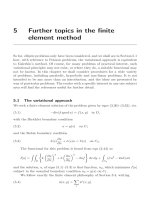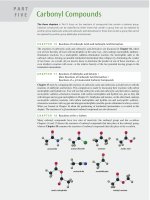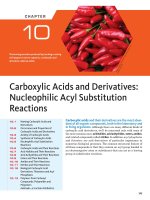Ebook Fundamentals of organic chemistry (7th edition) Part 1
Bạn đang xem bản rút gọn của tài liệu. Xem và tải ngay bản đầy đủ của tài liệu tại đây (14.51 MB, 342 trang )
Structures of Some Common Functional Groups
Name
Alkene
(double bond)
Alkyne
(triple bond)
Structure*
C
Name ending
-ene
H2CPCH2
Ethene
-yne
HCqCH
Ethyne
C
OCqCO
Arene
(aromatic ring)
Example
None
Benzene
Halide
C
None
X
CH3Cl
Chloromethane
(X ϭ F, Cl, Br, I)
Alcohol
Ether
C
C
-ol
OH
O
Monophosphate
O
P
O–
Amine
O–
-amine
C
Imine
(Schiff base)
N
None
N
C
C
O
؉N
C
C
SH
CH3OCH3
Dimethyl ether
CH3OPO32؊
Methyl phosphate
CH3NH2
Methylamine
NH
CH3CCH3
C
OCqN
Nitro
Thiol
phosphate
O
C
Nitrile
ether
C
CH3OH
Methanol
Acetone imine
-nitrile
CH3CqN
Ethanenitrile
None
CH3NO2
Nitromethane
-thiol
CH3SH
Methanethiol
O؊
*The bonds whose connections aren’t specified are assumed to be attached to carbon or hydrogen
atoms in the rest of the molecule.
Name
Sulfide
Structure*
C
S
Name ending
C
Disulfide
C
Carbonyl
S
S
Example
sulfide
CH3SCH3
Dimethyl sulfide
disulfide
CH3SSCH3
Dimethyl disulfide
C
O
C
Aldehyde
-al
O
C
Ketone
CH3CH
Ethanal
H
-one
O
C
Carboxylic acid
C
Ester
C
Propanone
-oic acid
Amide
C
Ethanoic acid
-oate
O
Carboxylic acid
anhydride
C
Methyl ethanoate
-amide
C
Carboxylic acid
chloride
C
C
-oic anhydride
C
Cl
O O
CH3COCCH3
C
Ethanoic anhydride
-oyl chloride
O
C
Ethanamide
O
O
O
CH3CNH2
N
O
O
CH3COCH3
C
O
C
O
CH3COH
OH
O
C
O
CH3CCH3
C
O
C
O
O
CH3CCl
Ethanoyl chloride
*The bonds whose connections aren’t specified are assumed to be attached to carbon or hydrogen
atoms in the rest of the molecule.
The results are in–and they
prove that OWL will help
you study smarter and
succeed in chemistry!
OWL for Organic Chemistry
The Chemist’s Choice. The Student’s Solution.
by Steve Hixson and Peter Lillya of the University of Massachusetts, Amherst
Strengthen your understanding with OWL, the #1 online
learning system for chemistry!
generated homework questions that provide instant,
answer-specific feedback.
Developed by chemistry instructors, OWL has already helped
hundreds of thousands of students master chemistry through
tutorials, interactive simulations, and algorithmically
OWL now features a modern, intuitive interface and is the only
system specifically designed to support mastery learning,
where you can work as long as you need to master each
chemical concept and skill.
The newest version of OWL for Organic Chemistry offers:
• A wide range of assignment types—tutorials,
interactive simulations, short answer questions, and algorithmically generated homework questions that provide
instant, answer-specific feedback, including end-ofchapter questions from your textbook
In addition, OWL also offers:
• e-Books, fully integrated electronic textbooks correlated to
OWL questions
• Quick Prep, a review course that helps you learn essential skills
you need to succeed in organic chemistry
• Jmol, a molecular visualization program for rotating molecules
and measuring bond distances and angles.
• MarvinSketch, an advanced molecular drawing program
for drawing gradable structures
“I attribute my good
grade in this course
largely to OWL.”
Student, Michigan
“I liked the step-by-step
tutorials and having
all the charts (periodic
table, etc.) a click away.”
Student, Texas
To learn more, visit us online at: www.cengage.com/OWL
FUNDA MEN TA L S OF
Organic
Chemistry
SEVENTH EDITION
John McMurry
Cornell University
Australia • Brazil • Japan • Korea • Mexico • Singapore • Spain • United Kingdom • United States
Fundamentals of Organic Chemistry,
Seventh Edition
John McMurry
Publisher: Mary Finch
Executive Editor: Lisa Lockwood
Developmental Editor: Sandi Kiselica
Assistant Editor: Elizabeth Woods
Senior Media Editor: Lisa Weber
© 2011, 2007 Brooks/Cole, Cengage Learning
ALL RIGHTS RESERVED. No part of this work covered by the copyright
herein may be reproduced, transmitted, stored, or used in any form
or by any means, graphic, electronic, or mechanical, including but not
limited to photocopying, recording, scanning, digitizing, taping, Web
distribution, information networks, or information storage and retrieval
systems, except as permitted under Section 107 or 108 of the 1976
United States Copyright Act, without the prior written permission of
the publisher.
Marketing Manager: Amee Mosley
Marketing Assistant: Kevin Carroll
Marketing Communications Manager:
Linda Yip
Content Project Manager: Teresa L. Trego
Creative Director: Rob Hugel
For product information and technology assistance, contact us at
Cengage Learning Customer & Sales Support, 1-800-354-9706
For permission to use material from this text or product,
submit all requests online at www.cengage.com/permissions
Further permissions questions can be e-mailed to
Art Director: John Walker
Print Buyer: Paula Vang
Library of Congress Control Number: 2009938743
Rights Acquisitions Account Manager, Text:
Tim Sisler
ISBN-13: 978-1-4390-4971-6
ISBN-10: 1-4390-4971-8
Rights Acquisitions Account Manager, Image:
Don Schlotman
Production Service: Graphic World Inc.
Text Designer: tani hasegawa
Photo Researcher: Scott Rosen,
Bill Smith Group
Copy Editor: Graphic World Inc.
OWL Producers: Stephen Battisti, Cindy
Stein, and David Hart in the Center
for Educational Software Development
at the University of Massachusetts, Amherst,
and Cow Town Productions
Illustrators: Graphic World Inc., 2064 Design
Cover Designer: Lee Friedman
Cover Image: Tim Fitzharris/Minden
Pictures/National Geographic Image
Collection
Compositor: Graphic World Inc.
Printed in the United States of America
1 2 3 4 5 6 7 13 12 11 10 09
Brooks/Cole
20 Davis Drive
Belmont, CA 94002-3098
USA
Cengage Learning is a leading provider of customized learning solutions
with office locations around the globe, including Singapore, the United
Kingdom, Australia, Mexico, Brazil, and Japan. Locate your local office at:
www.cengage.com/global
Cengage Learning products are represented in Canada by
Nelson Education, Ltd.
To learn more about Brooks/Cole, visit www.cengage.com/brookscole
Purchase any of our products at your local college store or at our
preferred online store, www.ichapters.com
1
Structure and Bonding; Acids and Bases 1
2
Alkanes: The Nature of Organic Compounds 38
3
Alkenes and Alkynes: The Nature of Organic Reactions 78
4
Reactions of Alkenes and Alkynes 112
5
Aromatic Compounds 155
6
Stereochemistry at Tetrahedral Centers 189
7
Organohalides: Nucleophilic Substitutions and Eliminations 222
8
Alcohols, Phenols, Ethers, and Their Sulfur Analogs 256
9
Aldehydes and Ketones: Nucleophilic Addition Reactions 294
10
Carboxylic Acids and Derivatives: Nucleophilic Acyl
Substitution Reactions 325
11
Carbonyl Alpha-Substitution Reactions and Condensation Reactions 372
12
Amines 404
13
Structure Determination 433
14
Biomolecules: Carbohydrates 469
15
Biomolecules: Amino Acids, Peptides, and Proteins 503
16
Biomolecules: Lipids and Nucleic Acids 538
17
The Organic Chemistry of Metabolic Pathways 571
APPENDIX A: Nomenclature of Polyfunctional Organic
Compounds A-1
APPENDIX B: Glossary
A-7
APPENDIX C: Answers to Selected In-Chapter Problems
INDEX
A-22
I-0–I-12
iii
1
Structure and Bonding;
Acids and Bases
1.1
1.2
1.3
1.4
1.5
1.6
1.7
1.8
1.9
1.10
1.11
1.12
Atomic Structure 2
Atomic Structure: Electron Configurations 4
Development of Chemical Bonding Theory 5
The Nature of Chemical Bonds 6
Forming Covalent Bonds: Valence Bond Theory 9
sp3 Hybrid Orbitals and the Structure of Methane 10
sp3 Hybrid Orbitals and the Structure of Ethane 11
Other Kinds of Hybrid Orbitals: sp2 and sp 12
Polar Covalent Bonds: Electronegativity 15
Acids and Bases: The Brønsted–Lowry Definition 18
Organic Acids and Organic Bases 22
Acids and Bases: The Lewis Definition 24
Organic Foods: Risk versus Benefit
Summary and Key Words 28
Exercises 29
INTERLUDE:
2
2.1
Alkanes: The Nature
of Organic Compounds
2.3
2.2
2.4
2.5
2.6
2.7
2.8
2.9
2.10
2.11
Functional Groups 39
Alkanes and Alkyl Groups: Isomers 44
Naming Branched-Chain Alkanes 49
Properties of Alkanes 53
Conformations of Ethane 54
Drawing Chemical Structures 56
Cycloalkanes 58
Cis–Trans Isomerism in Cycloalkanes 60
Conformations of Some Cycloalkanes 62
Axial and Equatorial Bonds in Cyclohexane 64
Conformational Mobility of Cyclohexane 65
Where Do Drugs Come From? 68
Summary and Key Words 69
Exercises 70
INTERLUDE:
3
Alkenes and Alkynes:
The Nature of Organic
Reactions
iv
3.1
3.2
3.3
3.4
3.5
Naming Alkenes and Alkynes 79
Electronic Structure of Alkenes 83
Cis–Trans Isomers of Alkenes 83
Sequence Rules: The E,Z Designation 86
Kinds of Organic Reactions 89
26
Contents
3.6
3.7
3.8
3.9
v
How Reactions Occur: Mechanisms 91
The Mechanism of an Organic Reaction: Addition
of HCl to Ethylene 95
Describing a Reaction: Transition States
and Intermediates 98
Describing a Reaction: Catalysis 101
INTERLUDE:
Terpenes: Naturally Occurring Alkenes 102
103
Summary and Key Words
Exercises 104
4
Reactions of Alkenes
and Alkynes
4.1
4.2
4.3
4.4
4.5
4.6
4.7
4.8
4.9
4.10
4.11
Addition of HX to Alkenes: Markovnikov’s Rule 113
Carbocation Structure and Stability 116
Addition of Water to Alkenes 117
Addition of Halogens to Alkenes 120
Reduction of Alkenes: Hydrogenation 122
Oxidation of Alkenes: Epoxidation, Hydroxylation,
and Cleavage 124
Addition of Radicals to Alkenes: Polymers 127
Conjugated Dienes 130
Stability of Allylic Carbocations: Resonance 132
Drawing and Interpreting Resonance Forms 133
Alkynes and Their Reactions 136
Natural Rubber 141
Summary and Key Words 142
Summary of Reactions 143
Exercises 146
INTERLUDE:
5
Aromatic Compounds
5.1
5.2
5.3
5.4
5.5
5.6
5.7
5.8
5.9
5.10
Structure of Benzene 156
Naming Aromatic Compounds 157
Electrophilic Aromatic Substitution Reactions:
Bromination 159
Other Electrophilic Aromatic Substitution Reactions 162
The Friedel–Crafts Alkylation and Acylation Reactions 165
Substituent Effects in Electrophilic Aromatic
Substitution 166
An Explanation of Substituent Effects 168
Oxidation and Reduction of Aromatic Compounds 171
Other Aromatic Compounds 172
Organic Synthesis 174
Aspirin, NSAIDs, and COX-2 Inhibitors 177
Summary and Key Words 179
Summary of Reactions 179
Exercises 181
INTERLUDE:
vi
Contents
6
6.1
Stereochemistry
at Tetrahedral Centers
6.3
6.2
6.4
6.5
6.6
6.7
6.8
6.9
6.10
Enantiomers and the Tetrahedral Carbon 190
The Reason for Handedness in Molecules: Chirality 191
Optical Activity 195
Pasteur’s Discovery of Enantiomers 197
Sequence Rules for Specifying Configuration 197
Diastereomers 201
Meso Compounds 204
Racemic Mixtures and the Resolution of Enantiomers 206
A Brief Review of Isomerism 208
Chirality in Nature and Chiral Environments 210
Chiral Drugs 212
Summary and Key Words 214
Exercises 214
INTERLUDE:
7
Organohalides:
Nucleophilic Substitutions
and Eliminations
7.1
7.2
7.3
7.4
7.5
7.6
7.7
7.8
7.9
7.10
Naming Alkyl Halides 223
Preparing Alkyl Halides 224
Reactions of Alkyl Halides: Grignard Reagents 226
Nucleophilic Substitution Reactions 227
Substitutions: The SN2 Reaction 230
Substitutions: The SN1 Reaction 234
Eliminations: The E2 Reaction 237
Eliminations: The E1 and E1cB Reactions 240
A Summary of Reactivity: SN1, SN2, E1, E1cB, and E2 241
Substitution and Elimination Reactions in Living
Organisms 242
INTERLUDE:
Naturally Occurring Organohalides 244
Summary and Key Words 245
Summary of Reactions 245
Exercises 247
8
Alcohols, Phenols, Ethers,
and Their Sulfur Analogs
8.1
8.2
8.3
8.4
8.5
8.6
8.7
8.8
Naming Alcohols, Phenols, and Ethers 257
Properties of Alcohols and Phenols: Hydrogen
Bonding and Acidity 259
Synthesis of Alcohols from Carbonyl Compounds 262
Reactions of Alcohols 268
Reactions of Phenols 274
Reactions of Ethers 276
Cyclic Ethers: Epoxides 277
Thiols and Sulfides 278
Contents
vii
Epoxy Resins and Adhesives 281
Summary and Key Words 282
Summary of Reactions 283
Exercises 286
INTERLUDE:
9
Aldehydes and Ketones:
Nucleophilic Addition
Reactions
9.1
9.2
9.3
9.4
9.5
9.6
9.7
9.8
9.9
9.10
The Nature of Carbonyl Compounds 295
Naming Aldehydes and Ketones 296
Synthesis of Aldehydes and Ketones 298
Oxidation of Aldehydes 299
Nucleophilic Addition Reactions 300
Nucleophilic Addition of Hydride and Grignard Reagents:
Alcohol Formation 302
Nucleophilic Addition of Water: Hydrate Formation 305
Nucleophilic Addition of Alcohols: Acetal Formation 306
Nucleophilic Addition of Amines: Imine Formation 310
Conjugate Nucleophilic Addition Reactions 311
Vitamin C 313
Summary and Key Words 314
Summary of Reactions 315
Exercises 316
INTERLUDE:
10
Carboxylic Acids and
Derivatives: Nucleophilic
Acyl Substitution Reactions
10.1
10.2
10.3
10.4
10.5
10.6
10.7
10.8
10.9
10.10
10.11
10.12
10.13
Naming Carboxylic Acids and Derivatives 326
Occurrence and Properties of Carboxylic Acids
and Derivatives 330
Acidity of Carboxylic Acids 331
Synthesis of Carboxylic Acids 334
Nucleophilic Acyl Substitution Reactions 335
Carboxylic Acids and Their Reactions 339
Acid Halides and Their Reactions 342
Acid Anhydrides and Their Reactions 344
Esters and Their Reactions 346
Amides and Their Reactions 349
Nitriles and Their Reactions 351
Biological Carboxylic Acid Derivatives: Thioesters
and Acyl Phosphates 354
Polymers from Carbonyl Compounds: Polyamides
and Polyesters 356
-Lactam Antibiotics
Summary and Key Words 360
Summary of Reactions 361
Exercises 363
INTERLUDE:
358
viii
Contents
11
Carbonyl Alpha-Substitution
Reactions and Condensation
Reactions
11.1
11.2
11.3
11.4
11.5
11.6
11.7
11.8
11.9
11.10
11.11
Keto–Enol Tautomerism 373
Reactivity of Enols: The Mechanism
of Alpha-Substitution Reactions 376
Alpha Halogenation of Aldehydes and Ketones 377
Acidity of Alpha Hydrogen Atoms:
Enolate Ion Formation 379
Reactivity of Enolate Ions 382
Alkylation of Enolate Ions 382
Carbonyl Condensation Reactions 385
Condensations of Aldehydes and Ketones:
The Aldol Reaction 386
Dehydration of Aldol Products: Synthesis of Enones 387
Condensations of Esters: The Claisen
Condensation Reaction 388
Some Biological Carbonyl Reactions 391
Barbiturates 392
Summary and Key Words 394
Summary of Reactions 394
Exercises 395
INTERLUDE:
12
Amines
12.1
12.2
12.3
12.4
12.5
12.6
12.7
Naming Amines 405
Structure and Properties of Amines 407
Basicity of Amines 408
Synthesis of Amines 411
Reactions of Amines 416
Heterocyclic Amines 417
Alkaloids: Naturally Occurring Amines 421
Green Chemistry
Summary and Key Words 423
Summary of Reactions 424
Exercises 425
INTERLUDE:
13
Structure Determination
13.1
13.2
13.3
13.4
13.5
13.6
13.7
13.8
422
Mass Spectrometry 434
Spectroscopy and the Electromagnetic Spectrum 435
Infrared Spectroscopy of Organic Molecules 438
Interpreting Infrared Spectra 439
Ultraviolet Spectroscopy 442
Interpreting Ultraviolet Spectra:
The Effect of Conjugation 443
Nuclear Magnetic Resonance Spectroscopy 445
The Nature of NMR Absorptions 446
Contents
13.9
13.10
13.11
13.12
13.13
13.14
Chemical Shifts 448
Chemical Shifts in 1H NMR Spectra 450
Integration of 1H NMR Spectra: Proton Counting 451
Spin–Spin Splitting in 1H NMR Spectra 452
Uses of 1H NMR Spectra 455
13C NMR Spectroscopy 456
Magnetic Resonance Imaging (MRI) 458
Summary and Key Words 459
Exercises 460
INTERLUDE:
14
Biomolecules: Carbohydrates
14.1
14.2
14.3
14.4
14.5
14.6
14.7
14.8
14.9
14.10
14.11
Classification of Carbohydrates 470
Depicting Carbohydrate Stereochemistry:
Fischer Projections 472
d,l Sugars 474
Configurations of Aldoses 476
Cyclic Structures of Monosaccharides:
Hemiacetal Formation 478
Monosaccharide Anomers: Mutarotation 480
Reactions of Monosaccharides 482
The Eight Essential Monosaccharides 487
Disaccharides 489
Polysaccharides 490
Cell-Surface Carbohydrates and Carbohydrate
Vaccines 492
Sweetness 494
Summary and Key Words 495
Exercises 496
INTERLUDE:
15
Biomolecules: Amino Acids,
Peptides, and Proteins
15.1
15.2
15.3
15.4
15.5
15.6
15.7
15.8
15.9
15.10
Structures of Amino Acids 504
Isoelectric Points 509
Peptides and Proteins 511
Covalent Bonding in Peptides 513
Peptide Structure Determination:
Amino Acid Analysis 514
Peptide Sequencing: The Edman Degradation 515
Peptide Synthesis 517
Protein Structure 521
Enzymes and Coenzymes 524
How Do Enzymes Work? Citrate Synthase 528
X-Ray Crystallography 530
Summary and Key Words 531
Exercises 532
INTERLUDE:
ix
x
Contents
16
Biomolecules: Lipids
and Nucleic Acids
16.1
16.2
16.3
16.4
16.5
16.6
16.7
16.8
16.9
16.10
16.11
Waxes, Fats, and Oils 539
Soaps 542
Phospholipids 544
Steroids 546
Nucleic Acids and Nucleotides 548
Base Pairing in DNA: The Watson–Crick Model 552
Replication of DNA 554
Transcription of DNA 555
Translation of RNA: Protein Biosynthesis 557
DNA Sequencing 560
The Polymerase Chain Reaction 562
DNA Fingerprinting 563
Summary and Key Words 564
Exercises 565
INTERLUDE:
17
The Organic Chemistry
of Metabolic Pathways
17.1
17.2
17.3
17.4
17.5
17.6
An Overview of Metabolism and Biochemical Energy
Catabolism of Fats: -Oxidation 575
Catabolism of Carbohydrates: Glycolysis 579
The Citric Acid Cycle 584
Catabolism of Proteins: Transamination 588
Some Conclusions about Biological Chemistry 590
572
Statin Drugs 591
Summary and Key Words 592
Exercises 593
INTERLUDE:
APPENDIX A:
Nomenclature of Polyfunctional
Organic Compounds A-1
APPENDIX B:
Glossary
APPENDIX C:
Answers to Selected In-Chapter Problems A-22
INDEX
I-0–I-12
A-7
Organic chemistry is changing rapidly. From its early days dealing primarily
with soaps and dyes, organic chemistry has moved to center stage in many fields,
from molecular biology to medicine and from agriculture to advanced electronics.
Today’s organic chemists are learning new languages—particularly those of
medicine and molecular biology—to shape the world we live in, and practitioners
in many other fields are finding themselves having to learn something of organic
chemistry. More than ever before, a fundamental understanding of organic
chemistry is critical to addressing complex, interdisciplinary problems.
This seventh edition of Fundamentals of Organic Chemistry addresses some
of the changes that are occurring by placing a greater emphasis on the applications of organic chemistry, especially applications to medicine and agriculture.
Many new examples of biological organic reactions have been added in this
edition; Interlude boxes at the end of each chapter are rich in the chemistry
of drugs and agrochemicals; and problem categories such as “In the Field” and
“In the Medicine Cabinet” reinforce the emphasis on applications.
This book is written for a one-semester course in organic chemistry, where
content must be comprehensive but to the point. Only those topics needed for
a brief course are covered, yet the important pedagogical tools commonly
found in larger books are also maintained. In this seventh edition, Fundamentals of Organic Chemistry continues its clear explanations, thought-provoking
examples and problems, and the trademark vertical format for explaining
reaction mechanisms.
The primary organization of this book is by functional group, beginning
with the simple (alkanes) and progressing to the more complex. Within the
primary organization, there is also an emphasis on explaining the fundamental mechanistic similarities of reactions, and several chapters even have a
dual title: Chapter 7 (Organohalides: Nucleophilic Substitutions and Eliminations), Chapter 9 (Aldehydes and Ketones: Nucleophilic Addition Reactions),
and Chapter 10 (Carboxylic Acids and Derivatives: Nucleophilic Acyl Substitution Reactions), for instance. Through this approach, memorization is minimized and understanding is maximized.
The first six editions of this text were widely regarded as the clearest and
most readable treatments of introductory organic chemistry available. I hope
you will find that this seventh edition of Fundamentals of Organic Chemistry
builds on the strengths of the first six and serves students even better. I have
made every effort to make this seventh edition as effective, clear, and readable
as possible; to show the beauty, logic, and relevance of organic chemistry; and
to make the subject interesting to learn. I welcome all comments on this new
edition as well as recommendations for future editions.
FEATURES
CONTINUED FROM
THE SIXTH EDITION
• Trademarked vertical reaction mechanisms give students easy-tofollow descriptions of each step in a reaction pathway. The number of
these vertical mechanisms has increased in every edition; see Figure
11.1 on page 375, for example, where the mechanisms of enol formation
under both acid-catalyzed and base-catalyzed conditions are compared.
xi
xii
Preface
• Full color throughout the text highlights the reacting parts of molecules to make it easier to focus on the main parts of a reaction.
• Nearly 100 electrostatic potential maps display the polarity patterns in molecules and the importance of these patterns in determining
chemical reactivity.
• More than 100 Visualizing Chemistry problems challenge students
to make the connection between typical line-bond drawings and molecular models.
• Each chapter contains many Worked Examples that illustrate how
problems can be solved, followed by a similar problem for the student
to solve. Each worked-out problem begins with a Strategy discussion
that shows how to approach the problem.
• More than 900 Problems are included both within the text and at the
end of every chapter.
• Current IUPAC nomenclature rules, as updated in 1993, are used to
name compounds in this text.
CHANGES AND
ADDITIONS FOR THE
SEVENTH EDITION
The primary reason for preparing a new edition is to keep the book up-to-date,
both in its scientific coverage and in its pedagogy. Global changes to the text
for this new edition include:
•
•
•
•
Writing has been revised at the sentence level.
Chemical structures have been redrawn.
Titles have been added to Worked Examples.
Brief paragraphs titled “Why This Chapter” have been added to chapter
introductions to explain the relevance of the chapter material to students.
• Many biologically oriented problems and examples have been added.
Specific changes and additions in individual chapters include:
• Chapter 1: A new Section 1.11, Organic Acids and Organic Bases, has
been added.
• Chapter 4: Coverage of epoxide formation and cleavage has been
added to Section 4.6.
• Chapter 5: A new Interlude, Aspirin, NSAIDs, and COX-2 Inhibitors,
has been added.
Coverage of biologically important aromatic heterocycles has been added
to Section 5.9.
• Chapter 7: Coverage of alkyl fluoride preparation from alcohols has
been added to Section 7.2.
Coverage of the biologically important E1cB reaction has been added to
Section 7.8.
• Chapter 8: Coverage of the Grignard reaction has been added to
Section 8.3.
Periodinane oxidation of alcohols has been added to Section 8.4.
A new Interlude, Epoxy Resins and Adhesives, has been added.
• Chapter 9: The former Sections 9.6 and 9.11 have been combined in a
new Section 9.6, Nucleophilic Addition of Hydride and Grignard
Reagents: Alcohol Formation.
A new Interlude, Vitamin C, has been added.
Preface
xiii
• Chapter 10: Coverage of the DCC method of amide synthesis has been
added to Section 10.10.
A new Section 10.12, Biological Carboxylic Acid Derivatives: Thioesters
and Acyl Phosphates, has been added.
Coverage of biodegradable polymers has been added to Section 10.13.
• Chapter 11: A new Interlude, Barbiturates, has been added.
• Chapter 12: Coverage of the azide synthesis of amines has been added
to Section 12.4.
A new Interlude, Green Chemistry, has been added.
• Chapter 13: The chapter has been reorganized to cover IR before UV.
• Chapter 14: A new subsection, Biological Ester Formation: Phosphorylation, has been added to Section 14.7.
A new Section 14.8, The Eight Essential Monosaccharides, has been
added.
• Chapter 15: Coverage of major coenzymes has been added to
Section 15.9.
A new Interlude, X-Ray Crystallography, has been added.
• Chapter 16: All material on nucleic acid chemistry has been updated.
• Chapter 17: A new Interlude, Statin Drugs, has been added.
BOOK SUPPORT
OWL Online Web Learning for Organic Chemistry
OWL for Organic Chemistry 1-Semester Instant Access
ISBN-10: 0-495-05101-2 | ISBN-13: 978-0-495-05101-5
OWL with e-Book for 1-Semester Instant Access
ISBN-10: 1-439-04976-9 | ISBN-13: 978-1-4390-4976-1
Authored by Steve Hixson, Peter Lillya, and Peter Samal, all of the University
of Massachusetts, Amherst. End-of-chapter questions authored by David W.
Brown, Florida Gulf Coast University.
Featuring a modern, intuitive interface, OWL for Organic Chemistry is a
customizable, online learning system and assessment tool that reduces faculty workload and facilitates instruction. You can select from various types of
assignments—including tutors, simulations, and short answer questions.
Questions are numerically, chemically, and contextually parameterized and
can accept superscript and subscript as well as structure drawings. With
parameterization, OWL for Organic Chemistry offers more than 6000 questions (including end-of-chapter questions specific to this textbook) and includes
MarvinSketch, an advanced molecular drawing program for drawing gradable
structures. In addition, when you become an OWL user, you can expect service
that goes far beyond the ordinary.
OWL is continually enhanced with online learning tools to address the
various learning styles of today’s students such as:
• e-Books, which offer a fully integrated electronic textbook correlated to
OWL questions
• Quick Prep review courses that help students learn essential skills to
succeed in General and Organic Chemistry
• Jmol molecular visualization program for rotating molecules and measuring bond distances and angles
• Parameterized end-of-chapter questions developed specifically for
this text
For more information or to see a demo, please contact your Cengage Learning representative or visit us at www.cengage.com/owl.
xiv
Preface
ExamView® Computerized Testing
This digital version of the Test Bank, revised by Tammy H. Tiner of Texas A&M
University, includes a variety of questions per chapter ranging from multiple
choice to matching. ISBN-10: 1-4390-5034-1 | ISBN-13: 978-1-4390-5034-7
Instructor’s Companion Website
Accessible from www.cengage.com/chemistry/mcmurry, this website provides
downloadable files for a library of images from the text as well as WebCT and
Blackboard versions of ExamView Computerized Testing.
Study Guide/Solutions Manual, by Susan McMurry
Contains answers to all problems in the text and helps students develop solid
problem-solving strategies required for organic chemistry. ISBN-10: 1-43904972-6 | ISBN-13: 978-1-4390-4972-3. Also available as an e-Book in OWL.
Pushing Electrons: A Guide for Students of Organic Chemistry, Third Edition, by
Daniel P. Weeks
Using this brief book, students learn to push electrons to generate resonance
structures and write organic mechanisms, an essential skill to learning
organic chemistry. ISBN-10: 0-03-020693-6 | ISBN-13: 978-0-03-020693-1
Organic Chemistry Modeling Kits
Cengage Learning offers a variety of organic chemistry model kits as a bundling option for students. Please consult with your Cengage Learning representative for pricing and selection.
Organic Chemistry Laboratory Manuals
Brooks/Cole, Cengage Learning is pleased to offer a choice of organic chemistry laboratory manuals catered to fit your needs. Visit www.cengage.com/
chemistry for preset lab manuals. For custom laboratory manuals, visit
www.signature-labs.com.
ACKNOWLEDGMENTS
I sincerely thank the many people whose help and suggestions were so valuable in preparing this seventh edition, particularly Sandi Kiselica, Lisa Lockwood, Lisa Weber, and Amee Mosley at Cengage Learning; Dan Fitzgerald at
Graphic World Inc., my wife, Susan, who read and improved the entire manuscript; and Professor Tom Lectka at Johns Hopkins University, who made
many valuable suggestions. I would also like to thank members of the reviewing panel, who graciously provided many helpful ideas for revising this text:
Robert Cameron, Samford University; Alvan C. Hengge, Utah State University; Steven Holmgren, Montana State University; and Richard P. Johnson,
University of New Hampshire.
CHAPTER
1
The enzyme HMG-CoA reductase, shown here as a
so-called ribbon model, catalyzes a crucial step in
the body’s synthesis of cholesterol. Understanding
how this enzyme functions has led to the development
of drugs credited with saving millions of lives.
Structure and Bonding;
Acids and Bases
Organic chemistry is all around us. The reactions
1.1
1.2
1.3
1.4
1.5
1.6
1.7
1.8
1.9
1.10
1.11
1.12
Atomic Structure
Atomic Structure: Electron Configurations
Development of Chemical Bonding Theory
The Nature of Chemical Bonds
Forming Covalent Bonds: Valence Bond Theory
sp3 Hybrid Orbitals and the Structure of
Methane
sp3 Hybrid Orbitals and the Structure of Ethane
Other Kinds of Hybrid Orbitals: sp2 and sp
Polar Covalent Bonds: Electronegativity
Acids and Bases: The Brønsted–Lowry
Definition
Organic Acids and Organic Bases
Acids and Bases: The Lewis Definition
Interlude—Organic Foods: Risk versus Benefit
Online homework for this chapter can be
assigned in OWL, an online homework
assessment tool.
and interactions of organic molecules allow us to see,
smell, fight, and fear. Organic chemistry provides the
molecules that feed us, treat our illnesses, protect our
crops, and clean our clothes. Anyone with a curiosity
about life and living things must have a basic understanding of organic chemistry.
Historically, the term organic chemistry dates to the
late 1700s, when it was used to mean the chemistry of
compounds found in living organisms. Little was known
about chemistry at that time, and the behavior of the
“organic” substances isolated from plants and animals
seemed different from that of the “inorganic” substances
found in minerals. Organic compounds were generally
low-melting solids and were usually more difficult to
isolate, purify, and work with than high-melting inorganic compounds. By the mid-1800s, however, it was
clear that there was no fundamental difference between
organic and inorganic compounds. The same principles explain the behaviors of all substances, regardless of origin or complexity. The only distinguishing characteristic of organic chemicals is that all contain the element
carbon (Figure 1.1).
1
2
CHAPTER 1 |
Structure and Bonding; Acids and Bases
Figure 1.1 The position of carbon
in the periodic table. Other elements commonly found in organic
compounds are shown in the colors
typically used to represent them.
Group
1A
8A
H
2A
3A
4A
5A
6A
7A
He
Li
Be
B
C
N
O
F
Ne
Na
Mg
Al
Si
P
S
Cl
Ar
K
Ca
Sc
Ti
V
Cr
Mn
Fe
Co
Ni
Cu
Zn
Ga
Ge
As
Se
Br
Kr
Rb
Sr
Y
Zr
Nb
Mo
Tc
Ru
Rh
Pd
Ag
Cd
In
Sn
Sb
Te
I
Xe
Cs
Ba
La
Hf
Ta
W
Re
Os
Ir
Pt
Au
Hg
Tl
Pb
Bi
Po
At
Rn
Fr
Ra
Ac
But why is carbon special? Why, of the more than 37 million presently
known chemical compounds, do more than 99% of them contain carbon? The
answers to these questions come from carbon’s electronic structure and its
consequent position in the periodic table. As a group 4A element, carbon can
share four valence electrons and form four strong covalent bonds. Furthermore, carbon atoms can bond to one another, forming long chains and rings.
Carbon, alone of all elements, is able to form an immense diversity of compounds, from the simple methane, with one carbon atom, to the staggeringly
complex DNA, which can have more than 100 million carbons.
Not all carbon compounds are derived from living organisms of course.
Modern chemists have developed a remarkably sophisticated ability to design
and synthesize new organic compounds in the laboratory—medicines, dyes,
polymers, and a host of other substances. Organic chemistry touches the lives
of everyone; its study can be a fascinating undertaking.
WHY THIS CHAPTER?
We’ll ease into the study of organic chemistry by first reviewing some ideas
about atoms, bonds, and molecular geometry that you may recall from your
general chemistry course. Much of the material in this chapter is likely to be
familiar to you, but some of it may be new and it’s a good idea to make sure
you understand it before going on.
1.1 Atomic Structure
As you probably know from your general chemistry course, an atom consists
of a dense, positively charged nucleus surrounded at a relatively large distance by negatively charged electrons (Figure 1.2). The nucleus consists of
subatomic particles called neutrons, which are electrically neutral, and protons, which are positively charged. Because an atom is neutral overall, the
number of positive protons in the nucleus and the number of negative electrons surrounding the nucleus are the same.
Although extremely small—about 10؊14 to 10؊15 meter (m) in diameter—
the nucleus nevertheless contains essentially all the mass of the atom. Electrons have negligible mass and circulate around the nucleus at a distance of
approximately 10؊10 m. Thus, the diameter of a typical atom is about
1.1
| Atomic Structure
3
2 ϫ 10؊10 m, or 200 picometers (pm), where 1 pm ϭ 10؊12 m. To give you an
idea of how small this is, a thin pencil line is about 3 million carbon atoms
wide. Many organic chemists and biochemists still use the unit angstrom (Å)
to express atomic distances, where 1 Å ϭ 100 pm ϭ 10؊10 m, but we’ll stay
with the SI unit picometer in this book.
Figure 1.2 A schematic view of an
Nucleus (protons + neutrons)
atom. The dense, positively charged
nucleus contains most of the atom’s
mass and is surrounded by negatively charged electrons. The threedimensional view on the right shows
calculated electron-density surfaces.
Electron density increases steadily
toward the nucleus and is 40 times
greater at the blue solid surface than
at the gray mesh surface.
Figure 1.3 Representations
of s and p orbitals. An s orbital
is spherical, while a p orbital
is dumbbell-shaped and can
be oriented along any of three
mutually perpendicular directions. Each p orbital has two
lobes separated by a node. The
two lobes have different algebraic signs in the corresponding wave function, as indicated
by the different colors.
Volume around nucleus
occupied by orbiting electrons
A specific atom is described by its atomic number (Z), which gives the number of protons (or electrons) it contains, and its mass number (A), which gives
the total number of protons plus neutrons in its nucleus. All the atoms of a
given element have the same atomic number—1 for hydrogen, 6 for carbon,
15 for phosphorus, and so on—but they can have different mass numbers
depending on how many neutrons they contain. Atoms with the same atomic
number but different mass numbers are called isotopes.
The weighted average mass in atomic mass units (amu) of an element’s
naturally occurring isotopes is called the element’s atomic mass (or atomic
weight)—1.008 amu for hydrogen, 12.011 amu for carbon, 30.974 amu for
phosphorus, and so on. Atomic masses of the elements are given in the periodic table in the back of this book.
What about the electrons? How are they distributed in an atom? According to
the quantum mechanical model of atomic structure, the behavior of a specific
electron in an atom can be described by a mathematical expression called a wave
equation—the same sort of expression used to describe the motion of waves in a
fluid. The solution to a wave equation is a wave function, or orbital, denoted by
the Greek letter psi, . An orbital can be thought of as defining a region of space
around the nucleus where the electron can most likely be found.
What do orbitals look like? There are four different kinds of orbitals,
denoted s, p, d, and f, each with a different shape. Of the four, we’ll be concerned only with s and p orbitals because these are the most common in
organic and biological chemistry. An s orbital is spherical, with the nucleus at
its center, while a p orbital is dumbbell-shaped and can be oriented in space
along any of three mutually perpendicular directions, arbitrarily denoted px,
py, and pz (Figure 1.3). The two parts, or lobes, of a p orbital have different
algebraic signs (ϩ and Ϫ) in the wave function and are separated by a region
of zero electron density called a node.
y
y
x
x
z
An s orbital
z
A 2px orbital
y
x
z
A 2py orbital
A 2pz orbital
4
CHAPTER 1 |
Structure and Bonding; Acids and Bases
Figure 1.4 The energy levels of elec-
Orbitals are organized into different layers around the nucleus of successively larger size and energy. Different layers, or electron shells, contain different numbers and kinds of orbitals, and each orbital can be occupied by
2 electrons. The first shell contains only a single s orbital, denoted 1s, and
thus holds only 2 electrons. The second shell contains an s orbital (designated
2s) and three mutually perpendicular p orbitals (each designated 2p) and thus
holds a total of 8 electrons. The third shell contains an s orbital (3s), three
p orbitals (3p), and five d orbitals (3d), for a total capacity of 18 electrons.
These orbital groupings are shown in Figure 1.4.
Energy
trons in an atom. The first shell holds a
maximum of 2 electrons in one 1s orbital;
the second shell holds a maximum of
8 electrons in one 2s and three 2p orbitals; the third shell holds a maximum of
18 electrons in one 3s, three 3p, and five
3d orbitals; and so on. The 2 electrons in
each orbital are represented by up and
down arrows, hg. Although not shown,
the energy level of the 4s orbital falls
between 3p and 3d.
3rd shell
(capacity—18 electrons)
3d
3p
3s
2nd shell
(capacity—8 electrons)
2p
2s
1st shell
(capacity—2 electrons)
1s
1.2 Atomic Structure: Electron Configurations
The lowest-energy arrangement, or ground-state electron configuration, of an
atom is a listing of the orbitals that the atom’s electrons occupy. We can predict this arrangement by following three rules.
RULE 1
The orbitals of lowest energy are filled first, according to the order 1s n 2s n
2p n 3s n 3p n 4s n 3d, as shown in Figure 1.4.
RULE 2
Only two electrons can occupy an orbital, and they must be of opposite spin.
(Electrons act in some ways as if they were spinning on an axis, somewhat
as the earth spins. This spin can have two orientations, denoted as up h and
down g.)
RULE 3
If two or more empty orbitals of equal energy are available, one electron occupies each with the spins parallel until all orbitals are half-full.
Some examples of how these rules apply are shown in Table 1.1. Hydrogen,
for instance, has only one electron, which must occupy the lowest-energy
Table 1.1
Element
Ground-State Electron Configuration of Some Elements
Atomic
number
Configuration
Element
Phosphorus
Atomic
number
15
Configuration
Hydrogen
1
1s
Carbon
6
2p
3s
2s
2p
1s
2s
3p
1s
1. 3
| Development of Chemical Bonding Theory
5
orbital. Thus, hydrogen has a 1s ground-state electron configuration. Carbon
has six electrons and the ground-state electron configuration 1s2 2s2 2p2. Note
that a superscript is used to represent the number of electrons in a particular
orbital.
Worked Example 1.1
Assigning an Electron Configuration to an Element
Give the ground-state electron configuration of nitrogen.
Strategy
Find the atomic number of nitrogen to see how many electrons it has, and then
apply the three rules to assign electrons into orbitals according to the energy
levels given in Figure 1.4.
Solution
Nitrogen has atomic number 7 and thus has seven electrons. The first two
electrons go into the lowest-energy orbital (1s2), the next two go into the secondlowest-energy orbital (2s2), and the remaining three go into the next-lowestenergy orbitals (2p3), with one electron in each. Thus, the configuration of
nitrogen is 1s2 2s2 2p3.
Problem 1.1
How many electrons does each of the following elements have in its outermost
electron shell?
(a) Potassium
Problem 1.2
(b) Calcium
(c) Aluminum
Give the ground-state electron configuration of the following elements:
(a) Boron
(b) Phosphorus
(c) Oxygen
(d) Argon
1.3 Development of Chemical Bonding Theory
By the mid-1800s, the new science of chemistry was developing rapidly
and chemists had begun to probe the forces holding molecules together.
In 1858, August Kekulé and Archibald Couper independently proposed
that, in all organic compounds, carbon is tetravalent; that is, it always
forms four bonds when it joins other elements to form chemical compounds.
Furthermore, said Kekulé, carbon atoms can bond to one another to form
extended chains of linked atoms and chains can double back on themselves
to form rings.
Although Kekulé and Couper were correct in describing the tetravalent
nature of carbon, chemistry was still viewed in a two-dimensional way until
1874. In that year, Jacobus van’t Hoff and Joseph Le Bel added a third
dimension to our ideas about organic compounds. They proposed that the
four bonds of carbon are not oriented randomly but have specific spatial
directions. Van’t Hoff went even further and suggested that the four atoms to
which carbon is bonded sit at the corners of a regular tetrahedron, with
carbon in the center.
A representation of a tetrahedral carbon atom is shown in Figure 1.5. Note
the conventions used to show three-dimensionality: solid lines represent
bonds in the plane of the page, the heavy wedged line represents a bond coming out of the page toward the viewer, and the dashed line represents a bond
receding back behind the page away from the viewer. These representations
will be used throughout this text.
6
CHAPTER 1 |
Structure and Bonding; Acids and Bases
Figure 1.5 A representation of
van’t Hoff’s tetrahedral carbon atom.
The solid lines represent bonds in the
plane of the paper, the heavy wedged
line represents a bond coming out of
the plane of the page, and the dashed
line represents a bond going back
behind the plane of the page.
Bond receding
into page
H
Bonds in plane
of page
H
C
H
H
Bond coming
out of plane
A regular
tetrahedron
A tetrahedral
carbon atom
Problem 1.3
Draw a molecule of chloromethane, CH3Cl, using solid, wedged, and dashed
lines to show its tetrahedral geometry.
Problem 1.4
Convert the following molecular model of ethane, C2H6, into a structure that
uses wedged, normal, and dashed lines to represent three-dimensionality.
Ethane
1.4 The Nature of Chemical Bonds
Why do atoms bond together, and how can bonds be described electronically?
The why question is relatively easy to answer: atoms bond together because
the compound that results is more stable and lower in energy than the separate atoms. Energy (usually as heat) is always released and flows out of the
chemical system when a bond forms. Conversely, energy must be put into the
system to break a bond. Making bonds always releases energy, and breaking
bonds always absorbs energy. The how question is more difficult. To answer it,
we need to know more about the electronic properties of atoms.
We know through observation that eight electrons—an electron octet—in
an atom’s outermost shell, or valence shell, impart special stability to the
noble-gas elements in group 8A of the periodic table: Ne (2 ϩ 8); Ar (2 ϩ 8 ϩ
8); Kr (2 ϩ 8 ϩ 18 ϩ 8). We also know that the chemistry of main-group elements is governed by their tendency to take on the electron configuration of
the nearest noble gas. The alkali metals in group 1A, for example, achieve a
noble-gas configuration by losing the single s electron from their valence shell
to form a cation, while the halogens in group 7A achieve a noble-gas configuration by gaining a p electron to fill their valence shell and form an anion. The
1. 4
| The Nature of Chemical Bonds
7
resultant ions are held together in compounds like Na؉ Cl؊ by an electrostatic attraction that we call an ionic bond.
How, though, do elements near the middle of the periodic table form bonds?
Look at methane, CH4, the main constituent of natural gas, for example. The
bonding in methane is not ionic because it would take too much energy for
carbon (1s2 2s2 2p2) to either gain or lose four electrons to achieve a noble-gas
configuration. As a result, carbon bonds to other atoms, not by gaining or losing electrons, but by sharing them. Such a shared-electron bond, first proposed in 1916 by G. N. Lewis, is called a covalent bond. The neutral group of
atoms held together by covalent bonds is called a molecule.
A simple way of indicating the covalent bonds in molecules is to use what
are called Lewis structures, or electron-dot structures, in which the valenceshell electrons of an atom are represented as dots. Thus, hydrogen has one dot
representing its 1s electron, carbon has four dots (2s2 2p2), oxygen has six dots
(2s2 2p4), and so on. A stable molecule results whenever a noble-gas configuration is achieved for all the atoms—eight dots (an octet) for main-group atoms
or two dots for hydrogen. Simpler still is the use of Kekulé structures, or
line-bond structures, in which a two-electron covalent bond is indicated as a
line drawn between atoms.
H
H C H
H
Electron-dot structures
(Lewis structures)
H N H
H
H
H C OH
H
H O H
H
Line-bond structures
(Kekulé structures)
H
C
H
H
H
N
H
H
H
Methane
(CH4)
Ammonia
(NH3)
O
H
H
H
C
O
H
H
Water
(H2O)
Methanol
(CH3OH)
The number of covalent bonds an atom forms depends on how many additional valence electrons it needs to reach a noble-gas configuration. Hydrogen
has one valence electron (1s) and needs one more to reach the helium configuration (1s2), so it forms one bond. Carbon has four valence electrons (2s2 2p2)
and needs four more to reach the neon configuration (2s2 2p6), so it forms four
bonds. Nitrogen has five valence electrons (2s2 2p3), needs three more, and
forms three bonds; oxygen has six valence electrons (2s2 2p4), needs two more,
and forms two bonds; and the halogens have seven valence electrons, need one
more, and form one bond.
H
One bond
C
Four bonds
N
Three bonds
F
Cl
Br
I
O
Two bonds
One bond
Valence electrons that are not used for bonding are called lone-pair
electrons, or nonbonding electrons. The nitrogen atom in ammonia (NH3), for
instance, shares six valence electrons in three covalent bonds and has its









